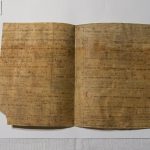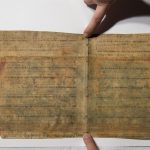The musical notation on the fragment are dominated by Messine (Laon, Lotharingian) signs, which usually was mixed with German neumes on the staves, some time before the codex behind the fragment was written down. But our fragment is more than just an early witness of this Messine-German mixed notation: the influence of Middle French notation can also be detected in it (see below). Of the German neumes, the most interesting is the quilisma written on the staves and its combinations, but this notation does not provide any information about the interpretation of the sign in question. In addition, cephalicus and a very large variety of strophicus preserve traces of the differentiated sign set of earlier neume notations. The notator uses two basic syllabic signs: punctum (tractulus) and virga, the latter indicate a higher single note, but not always consistently. Not for Messine notation, but typical of Middle French notation, we note Guido Arezzo’s coloured staff-system: the F-line is written in red and the C-line appears to be coloured (yellow), but this cannot be taken for granted due to the wear of the parchment. The shape of the B-key is archaic, dating back to the 12th century. It is curious that this notation uses custos, unlike the Messine notation, which is also typical of the Middle French notational school. One can observe in the 12th century French-Messine angular, pointed neume elements in the fragment (see, for example, the pointed French torculus variant). The spurred pes and the resulting (French) pes+virga scandicus combination at larger intervals are characteristic, and are also a special feature of the pre-Esztergom notation from the time (see notations in the Pray Codex). It is interesting that its opposite, the Messine punctum+pes scandicus structure, is not shown. The climacus here tilts to the right, but an earlier vertical variant is also observed. Typical Messine elements are the Arabic 7-form clivis and the 9-form cephalicus. Unfortunately, the diversity of the notation does not allow a geographical delimitation of the fragment.
In terms of the liturgical content, the bifolio preserves parts of chants for Holy Saturday, Easter Sunday and Easter Octave. These are problematic liturgical places, if traces of local tradition are sought. The material for Holy Saturday and Easter is firmly fixed, and there is no sign of specific local variation. By contrast, the material from the Easter Octave tends to be highly variable (especially the exact assimilation of the canticle antiphons), which prevents the traditions from being separated from each other. Thus, the local tradition behind the fragment cannot be identified on the basis of the surviving liturgical parts. The notation may suggest a Franco-German borderland.
The identity of Josephus Securius, one time possessor of the host book, has been revealed: he was a protestant doctor, a member of the circle around Comenius. Like many other Reformed pastors of his time, he fled from Moravia to Szakolca, but he could not live in peace: he was arrested for his involvement in the Wesselényi uprising. He was a bibliophile scholar, and several of his volumes can be identified from his entries. In addition to these, a volume with his possessor inscription can be found in the Roman Catholic Diocesan Library of Oradea, see András Emődi, Old Collection of the Roman Catholic Diocesan Library of Oradea I. Budapest – Nagyvárad, Akadémiai Kiadó, Egyházmegyei Könyvtár, OSZK, 2005, Ant. 337.
Gabriella Gilányi



